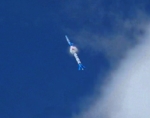Stability problems (still...)
-
Sitell
- New Member
- Posts: 4
- Joined: Tue Oct 13, 2009 3:50 pm
Stability problems (still...)
I have constructed and built my first water rocket but it only goes a few meter up in the air before it starts tumbling to the side (in all maximum four meters up) .
I can´t figure out why it does not fly better. I use a Gardena nozzle and guides as shown in the pictures. The bottle does not have fins because I thought the bottle/rocket could fly without them.
Do anyone have any idea what could be the problems?
I can´t figure out why it does not fly better. I use a Gardena nozzle and guides as shown in the pictures. The bottle does not have fins because I thought the bottle/rocket could fly without them.
Do anyone have any idea what could be the problems?
- Attachments
-
- Release.JPG (30.6 KiB) Viewed 135 times
-
- Nozzle.JPG (21.13 KiB) Viewed 135 times
-
- Guides.JPG (40.58 KiB) Viewed 135 times
-
WRA2

- Site Admin

- Posts: 1089
- Joined: Sat Dec 30, 2006 11:30 pm
Re: Stability problems (still...)
You need to add fins for stable flight especially when using a gardenia nozzle as the weight of the nozzle will contribute to the instability.
Welcome to the forum
Welcome to the forum
Lisa Walker,
 Forum Administrator.
Forum Administrator. 
 The Water Rocket Achievement World Record Association
The Water Rocket Achievement World Record Association 
-
air.command
- Senior Member

- Posts: 183
- Joined: Wed Jul 09, 2008 5:20 am
Re: Stability problems (still...)
Hi Sitell,
A bottle by itself is usually ustable so the behaviour you are describing is very typical. Quite easy to fix though. Add some fins, and a weight on the nose and you should be good to go. This article may help shed some light on the problem:
http://www.aircommandrockets.com/flying_straight.htm
- George
A bottle by itself is usually ustable so the behaviour you are describing is very typical. Quite easy to fix though. Add some fins, and a weight on the nose and you should be good to go. This article may help shed some light on the problem:
http://www.aircommandrockets.com/flying_straight.htm
- George
http://www.AirCommandRockets.com
-
U.S. Water Rockets1

- WRA2 Member

- Posts: 1778
- Joined: Sat Feb 03, 2007 3:24 pm
Re: Stability problems (still...)
You definitely need to have fins. Even our very long rockets are not stable without fins on them. A short bottle is even less stable than our long thin rockets and it will lose stable flight shortly after liftoff. Try putting some fins on the back of the rocket and you will not have any more problems.Sitell wrote:I have constructed and built my first water rocket but it only goes a few meter up in the air before it starts tumbling to the side (in all maximum four meters up) .
I can´t figure out why it does not fly better. I use a Gardena nozzle and guides as shown in the pictures. The bottle does not have fins because I thought the bottle/rocket could fly without them.
Do anyone have any idea what could be the problems?
Team U.S. Water Rockets
Visit USWaterRockets.com
Visit our Blog
Tune in to our YouTube Channel
Visit our Facebook page
Visit our Twitter Page
Opportunity is missed by most people because it is dressed in overalls and looks like work. --Thomas Edison
Visit USWaterRockets.com
Visit our Blog
Tune in to our YouTube Channel
Visit our Facebook page
Visit our Twitter Page
Opportunity is missed by most people because it is dressed in overalls and looks like work. --Thomas Edison
-
Sitell
- New Member
- Posts: 4
- Joined: Tue Oct 13, 2009 3:50 pm
Re: Stability problems (still...)
Hello
Thanks a lot for your kind answers. I will try to add some fins. Im glad to hear that you all think that "missing" fins couses the stability problems.
/karl
Thanks a lot for your kind answers. I will try to add some fins. Im glad to hear that you all think that "missing" fins couses the stability problems.
/karl
-
Tim Chen

- WRA2 Member

- Posts: 871
- Joined: Wed Jan 31, 2007 1:44 am
Re: Stability problems (still...)
Sitell wrote:Hello
Thanks a lot for your kind answers. I will try to add some fins. Im glad to hear that you all think that "missing" fins couses the stability problems.
/karl
I agree with the above. I have proved it experimentally. I tested a launcher I made by using plain bottles and they all flew up and went crazy. I didn't care because they were empty bottles.
Later on I launched my real rocket with fins and it flew perfectly.
Tim Chen
Captain, Team Enterprise
Captain, Team Enterprise
-
danb
- Advanced Member

- Posts: 50
- Joined: Sun Sep 26, 2010 4:30 am
Re: Stability problems (still...)
Definately add fins and some weight at the top of the rocket another idea cut a top off another bottle to make a nose cone to make it more aerodynamic you should see some better results happy rocketing
danb
danb
-
Noodleman
- New Member
- Posts: 3
- Joined: Sun Mar 12, 2017 8:12 pm
Re: Stability problems (still...)
I also have the same problem. But, it tumbles only when the rocket is filled with water. Whenever i do an all air launch, it flies perfectly straight up without the need of any fins or nose cones. How does this happen?
-
anoymous

- Senior Member

- Posts: 128
- Joined: Thu Mar 19, 2015 2:52 pm
Re: Stability problems (still...)
Just add fins and nose cone
It really will help.
I dont know why the air only launch was more stable, maybe bc it generated less thrust?
It really will help.
I dont know why the air only launch was more stable, maybe bc it generated less thrust?
"Only two things are infinite, the universe and human stupidity, and I'm not sure about the former."
- Albert Einstein
Sorry for malconstructions in my sentences, I am Belgian. And I was never good at making easy sentences.
- Albert Einstein
Sorry for malconstructions in my sentences, I am Belgian. And I was never good at making easy sentences.
-
anachronist

- WRA2 Member

- Posts: 244
- Joined: Sun May 07, 2017 2:18 pm
Re: Stability problems (still...)
In physics terms, we are dealing with the center of mass versus the center of pressure.Noodleman wrote:I also have the same problem. But, it tumbles only when the rocket is filled with water. Whenever i do an all air launch, it flies perfectly straight up without the need of any fins or nose cones. How does this happen?
Center of mass is the point where the rocket balances horizontally.
Center of pressure is the point where wind blowing on the rocket in any direction exerts an equal turning force on either side of the point.
For stability, the center of mass must be ahead of the center of pressure.
Think of an arrow with fletching (feathers) on at the tail end. The center of mass will be about the middle of the arrow. You can balance it on your finger at that point in still air. To find the center of pressure, you would hold the arrow horizontally between two fingers on a windy day, and find the point along the length to hold it where the arrow doesn't turn into the wind. Because the feathers exert a turning force, you will have to hold the arrow farther toward the back to find this balance point. The center of mass is in front of the center of pressure.
In an all-air launch, the mass of the bottle is probably about the middle of the bottle, maybe a bit toward the base if the base is a heavier material (it's usually a bit thicker there). The center of pressure may be about the same place, or even slightly behind the center of mass, so the bottle won't have much reason to turn (if the center of mass and center of pressure are in the same place, there's no reason not to turn either, so typically we see finless bottles as unstable).
Similarly, if you remove the fletching from an arrow, it might fly straight, or it might not. A feather-less arrow will fly reasonably straight if you add weight to the nose, because the body of the arrow provides a weak weathervane effect.
Now consider when the bottle is full. Almost all the weight is at the back. Suddenly the only "fin" available (the body of the rocket) is ahead of this mass. So it will try to flip around, just as if you tried to launch a rocket backward, or tried to push a boat through the water rudder-first. This, by the way, is also why it's so hard to keep a canoe on a straight path when you're the only occupant and sitting toward the back: the body of the canoe is acting like a rudder and it's in front of you, causing the canoe to want to turn.
If you add fins (this site has a good tutorial on how to create "box fins" which you can do with cardboard), then you shift the center of pressure backward. Sweeping the fins back (not just sticking straight out) puts the fin area even further back for better stability.

